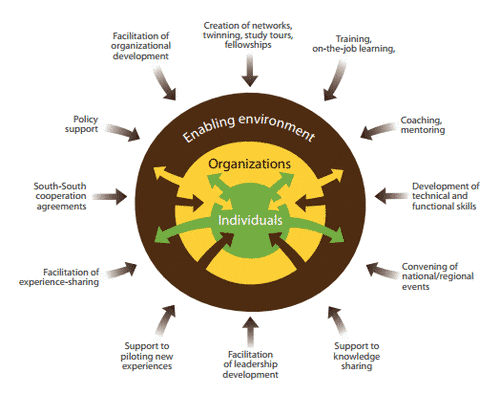How to design capacity development interventions and ensure their sustainability
What does designing capacity development interventions involve?
Designing capacity development interventions is a crucial step during the formulation phase of a project. It is the opportunity to think strategically about innovative ways in which capacities of country actors are developed in order to contribute to the success of the project. Ideally, a capacity assessment has been carried out, whereby capacity strengths and gaps have been revealed, and opportunities for change have been identified.
It is a moment to consider which combinations of capacity development activities are most appropriate, in order to effectively strengthen the capacity of state and non-state actors. The more time and effort goes into planning and designing, the more likely the project is to be successful and sustainable.
How to design capacity development activities in a project?
So where do we begin, and how do we start designing? The capacity assessment has revealed the capacity strengths and weaknesses of country actors. Now is the time to consider which activities are most appropriate to strengthen their capacities.
The key considerations when selecting capacity development activities are:
What are the priority issues? What main capacity gaps and strengths did the capacity assessment reveal, and which issues should be addressed as a priority? As there are rarely enough resources to address all capacity gaps, identifying a few priorities is a good way forward.
What are the key opportunities? How much incentive, momentum and demand is there among country actors? Building on a country own motivation and readiness for change is key to smart project design.
How should activities be ordered or sequenced? What capacity development activities are prerequisites for the effectiveness of others? Are there any short-term activities that could set the stage for longer-term support? Are there any “quick-wins”? Remember that capacity development is a process: initially small results can create momentum, and give way to new opportunities. Capacity development planning should, where possible, be continually adjusted, in accordance with emerging opportunities. See FAO’s story on Expanding Agricultural Trade Expertise in Post-Soviet Countries, for an example on successfully sequenced capacity development activities.
What is realistic? Given the financial and human resources available, what activities are most realistic?
Remember when choosing your activities, to consider both technical and functional capacities, within all three dimensions of capacity development: individuals, organizations and the enabling environment. See FAO’s story on Enhancing country capacities to report on greenhouse gas emissions, for examples of how this has been done.
The graphic below shows a selection of capacity development activities. It also reminds us that capacity development goes beyond training activities.
Capacity Development Activities

Why is it important to consider sustainability during the design phase?
A project is sustainable when its benefits are maintained and scaled up beyond the end of the intervention. As we have seen, the design phase is a strategic and decisive moment during a project. It is therefore crucial to consider whether the choices being made are conducive to effective and lasting change.
How can we consider sustainability during project design?
The main elements to consider for sustainable capacity development are:
Involvement of local and national actors: to what extent are local or national actors (i.e. government partners, research institutes, civil society organizations, the private sector, etc) involved in the project? Do they have ownership of the project, and will they be equipped to maintain and upscale the results after the project’s end? See FAO’s stories on Deepening country ownership for the governance of tenure in Myanmar, and on Making the Great Green Wall a reality: one country at a time, for examples of how to ensure that country actors are in the lead and have full ownership of their projects.
Policy support and commitment:How committed is the government and how favourable is the policy environment to the changes being proposed? Is the project supported by ‘national champions’, who have the power and authority to influence policy changes?
Absorption of new knowledge in institutions:How can we ensure that new knowledge, skills and procedures are integrated into the existing structures of the institution(s) with which we are working? In other words, how can we make sure that the knowledge that has been transferred becomes the convention or norm in the institution?
Financial viability:What financial provisions are in place to ensure that the project outcomes are financially viable beyond the project’s end?
After-project vision:Does the project have an ‘after-project vision’? Are our partners closely involved in formulating this vision/strategy? Who will take over which responsibilities at the end of the project and how?
Commonly used tools
A table outlining a selection of capacity development activities, with guidance on when and how to use them. | |
A table listing the different elements of sustainability, with tips on how to embed them into a project. |
